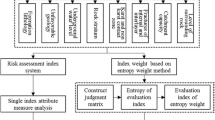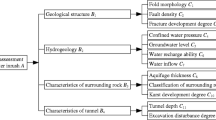Abstract
Water inrush is one of the most serious geological hazards in underground engineering construction. In order to effectively prevent and control the occurrence of water inrush, a new attribute interval recognition theory and method is proposed to systematically evaluate the risk of water inrush in karst tunnels. Its innovation mainly includes that the value of evaluation index is an interval rather than a certain value; the single-index attribute evaluation model is improved non-linearly based on the idea of normal distribution; the synthetic attribute interval analysis method based on improved intuitionistic fuzzy theory is proposed. The TFN-AHP method is proposed to analyze the weight of evaluation index. By analyzing geological factors and engineering factors in tunnel zone, a multi-grade hierarchical index system for tunnel water inrush risk assessment is established. The proposed method is applied to ventilation incline of Xiakou tunnel, and its rationality and practicability is verified by comparison with field situation and evaluation results of other methods. In addition, the results evaluated by this method, which considers that water inrush is a complex non-linear system and the geological conditions have spatial variability, are more accurate and reliable. And it has good applicability in solving the problem of certain and uncertain problem.
摘要
突涌水灾害是地下工程建设过程中最严重的地质灾害之一。为了实现突涌水灾害的有效主动防 控,提出了一种新的属性区间辨识模型来系统地评价岩溶隧道突涌水风险。其创新主要在于评价指标 的取值是一个区间,而不是一个确定值;引入正态分布理念对传统属性综合评价模型进行非线性改进, 提出基于改进直觉模糊理论的综合属性区间测度分析方法;并采用TFN-AHP 法进行突涌水评价指标 权重分析。同时,通过分析岩溶隧道突涌水灾害的地质影响因素和工程影响因素,建立了一个多层次 突涌水风险评价指标体系。将建立的评价方法应用于峡口隧道斜井某段的突涌水风险分析,通过与现 场情况和其他方法的评估结果对比,验证了该方法的合理性与实用性。此外,本方法考虑了突涌水这 一复杂非线性系统与围岩的空间变异性,评价结果更准确、可靠;且在解决确定与不确定问题方面具 有较好的适用性。
Similar content being viewed by others
References
LI T Z, YANG X L. Risk assessment model for water and mud inrush in deep and long tunnels based on normal grey cloud clustering method[J]. KSCE Journal of Civil Engineering 2018, 22(5): 1991–2001. DOI 10.1007/s12205-017-0553-6
LI X Z, HUANG Z, XU Z H. Hazard-causing structures for water and mud inrush in tunnels and the corresponding detailed, multiscale observation technology [J]. China Journal of Highway and Transport, 2018, 31(10): 79–90. (in Chinese)
WANG J, LI S C, LI L P, LIN P, XU Z H, GAO C L. Attribute recognition model for risk assessment of water inrush [J]. Bulletin of Engineering Geology and the Environment, 2017, 78(2): 1057–1071. DOI 10.1007/s10064-017-1159-4.
LI S C, ZHOU Z Q, LI L P, XU Z H, ZHANG Q Q, SHI S S. Risk assessment of water inrush in karst tunnels based on attribute synthetic evaluation system [J]. Tunnel Underground Space Technology, 2013, 38: 50–58. DOI: https://doi.org/10.1016/j.tust.2013.05.001.
LI S C, WU J, XU Z H, LI L P. Unascertained measure model of water and mud inrush risk evaluation in karst tunnels and its engineering application [J]. KSCE Journal of Civil Engineering, 2017, 21(4): 1170–1182. DOI 10.1007/s12205-016-1569-z.
WANG S. Regional dynamic risk assessment and early warning of tunnel water inrush and application [D]. Ji’nan: Shandong University, 2016. (in Chinese)
ZhANG D, FANG Q, LOU H. Grouting techniques for the unfavorable geological conditions of Xiang’an subsea tunnel in China [J]. Journal Rock Mechanics and Geotechnical Engineering, 2014, 6(5): 438–446. DOI: http://dx.doi.org/10.1016/j.jrmge.2014.07.005.
LI Li-ping, LI Shu-cai, ZHANG Qing-song. Study of mechanism of water inrush induced by hydraulic fracturing in karst tunnels [J]. Rock and Soil Mechanics, 2010, 31(2): 523–528. DOI:10.16285/j.rsm.2010.02.016.
YANG T H, LIU J, ZHU W C, ELSWORTH D, THAM L G, TANG C A. A coupled flow-stress-damage model for groundwater outbursts from an underlying aquifer intomining excavations [J]. International Journal of Rock Mechanics & Mining Sciences, 2007, 44: 87–97. DOI: https://doi.org/10.1016/j.ijrmms.2006.04.012.
ZHAO J, YIN L, GUO W. Stress–seepage coupling of cataclastic rock masses based on digital image technologies [J]. Rock Mechanics and Rock Engineering, 2018, 51: 2355–2372. DOI: https://doi.org/10.1007/s00603-018-1474-5.
LI S C, GAO C L, ZHOU Z Q, LI L P, WANG M X, YUAN Y C, WANG J. Analysis on the precursor information of water inrush in karst tunnels: A true triaxial model test study [J]. Rock Mechanics and Rock Engineering, 2019, 52: 373–384. DOI: https://doi.org/10.1007/s00603-018-1582-2.
YANG W M, WANG M X, ZHOU Z Q, LI L P, YUAN Y C, GAO C L. A true triaxial geomechanical model test apparatus for studying the precursory information of water inrush from impermeable rock mass failure [J]. Tunnelling and Underground Space Technology, 2019, 93: 103078. DOI: https://doi.org/10.1016/j.tust.2019.103078.
ESKESEN S D, TENGBORG P, KAMPMANN J, VEICHERTS T H. Guidelines for tunnelling risk management: International tunneling association [J]. Tunnelling and Underground Space Technology, 2004, 19(3): 217–237. DOI: 10.1016/j.tust.2004.01.001.
BUKOWSKI P. Water hazard assessment in active shafts in upper Silesian Coal Basin mines [J]. Mine Water and the Environment, 2011, 30(4): 302–311. DOI: 10.1007/s10230-011-0148-2.
ZHANG Q S, LI S C, HAN H W, GE Y H, LIU R T, ZHANG X. Study on risk evaluation and water inrush disaster preventing technology during construction of karst tunnels [J]. Journal of Shandong University: Engineering Science, 2009, 39(3): 106–110. (in Chinese)
XU Z H, LI S C, LI L P, HOU J G, SUI B, SHI S S. Risk assessment of water or mud inrush of karst tunnels based on analytic hierarchy process [J]. Rock and Soil Mechanics, 2011, 32(6): 1757–1766. (in Chinese)
LI S C, ZHOU Z Q, LI L P, SHI S S, XU Z H. Risk evaluation theory and method of water inrush in karst tunnels and its application [J]. Chinese Journal of Rock Mechanics and Engineering, 2013, 32(9): 1858–1867. (in Chinese)
LI L P, ZHOU Z Q, LI S C, XUE Y G, XU Z H, SHI S S. An attribute synthetic evaluation system for risk assessment of floor water inrush in coal mines [J]. Mine Water and the Environment, 2015, 3(34): 288–294. DOI 10.1007/s10230-014-0318-0.
WANG Y C, YIN X, JING H W, LIU R C, SU H J. A novel cloud model for risk analysis of water inrush in karst tunnels [J]. Environmental Earth Science, 2016, 75: 1450. DOI 10.1007/s12665-016-6260-7.
CHU H D, XU G L, YASUFUKU N., YU Z, LIU P L, WANG J F. Risk assessment of water inrush in karst tunnels based on two-class fuzzy comprehensive evaluation method [J]. Arabian Journal of Geosciences, 2017, 10: 179. DOI: 10.1007/s12517-017-2957-5.
YUAN Y C, LI S C, ZHANG Q Q, LI L P, SHI S S, ZHOU Z Q. Risk assessment of water inrush in karst tunnels based on a modified grey evaluation model: Sample as Shangjiawan Tunnel [J]. Geomechanics and Engineering, 2016, 11(4): 493–513. DOI: https://doi.org/10.12989/gae.2016.11.4.493.
ZHANG K, TANNANT D D, ZHENG W B, CHEN S G, TAN X R. Prediction of karst for tunnelling using fuzzy assessment combined with geological investigations [J]. Tunnelling and Underground Space Technology, 2018, 80: 64–77. DOI: https://doi.org/10.1016/j.tust.2018.06.009.
LI Xue-ping, LI Yun-an. Research on risk assessment system for water inrush in the karst tunnel construction based on GIS: Case study on the diversion tunnel groups of the Jinping II Hydropower Station [J]. Tunnelling and Underground Space Technology, 2014, 40: 182–191. DOI: http://dx.doi.org/10.1016/j.tust.2013.10.005.
LI L P, LEI T, LI S C, ZHANG Q Q, XU Z H, SHI S S, ZHOU Z Q. Risk assessment of water inrush in karst tunnels and software development [J]. Arabian Journal of Geosciences, 2015, 8: 1843–1854. DOI: 10.1007/s12517-014-1365-3
LI L P, LEI T, LI S C, XU Z H, XUE Y G, SHI S S. Dynamic risk assessment of water inrush in tunnelling and software development [J]. Geomechanics and Engineering, 2015, 9(1): 57–81. DOI: https://doi.org/10.12989/gae.2015.9.1.057
ATANASSOV K T. Intuitionistic fuzzy sets [J]. Fuzzy Sets and Systems, 1986, 20(1): 87–96. DOI: https://doi.org/10.1016/S0165-0114(86)80034-3.
ATANASSOV K T. Intuitionistic fuzzy sets: Theory and application [M]. Heidelberg: Physica-Verlag, 1999.
XU Z S, YAGER R R. Some geometric aggregation operators based on intuitionistic fuzzy sets [J]. International Journal of General System, 2006, 35(4): 417–433. DOI: https://doi.org/10.1080/03081070600574353.
KUMAR K, GARG H. Connection number of set pair analysis based TOPSIS method on intuitionistic fuzzy sets and their application to decision making [J]. Applied Intelligence, 2018, 48(8): 2112–2119. DOI: https://doi.org/10.1007/s10489-017-1067-0.
YIN Y, TIAN J, ZHANG Y J. Study on statistical analysis of karst tunnel disaster cases [J]. Highway Engineering, 2018, 43(4): 210–214. (in Chinese)
ZHOU Z Q, LI S C, LI L P, SHI S S, WANG K. Attribute recognition model of fatalness assessment of water inrush in karst tunnels and its application [J]. Rock and Soil Mechanics, 2013, 34(3): 818–826. (in Chinses)
WANG S, WEN T, YING S, CAI F, PANG B. Engineering application of attribute model with varying weights in risk identification of high and steep slope in Three Gorges Reservoir Area [J]. Ecology and Environmental Monitoring of Three Gorges, 2017, 2(4): 59–65.
ZHANG K, ZHENG W B, XU C, CHEN S G. Risk assessment of gas outburst in tunnels in non-coal formation based on the attribute mathematical theory [J]. Geomatics, Natural Hazards and Risk, 2019, 10(1): 483–504. DOI: https://doi.org/10.1080/19475705.2018.1530305.
ZHANG K, ZHENG W B, XU C, CHEN S G. An improved extension system for assessing risk of water inrush in tunnels in carbonate karst terrain [J]. KSCE Journal of Civil Engineering, 2019. DOI 10.1007/s12205-019-0756-0.
Author information
Authors and Affiliations
Corresponding author
Additional information
Foundation item: Project(51722904) supported by the National Science Fund for Excellent Young Scholars, China; Project(51679131) supported by the National Natural Science Foundation of China; Project(2019JZZY010601) supported by the Shandong Provincial Key Research and Development Program (Major Scientific and Technological Innovation Project), China; Project(KJ1712304) supported by the Science and Technology Research Program of Chongqing Municipal Education Commission, China; Project(2016XJQN13) supported by the Yangtze Normal University Research Project, China
Rights and permissions
About this article
Cite this article
Wang, S., Li, Lp., Cheng, S. et al. Risk assessment of water inrush in tunnels based on attribute interval recognition theory. J. Cent. South Univ. 27, 517–530 (2020). https://doi.org/10.1007/s11771-020-4313-2
Received:
Accepted:
Published:
Issue Date:
DOI: https://doi.org/10.1007/s11771-020-4313-2




